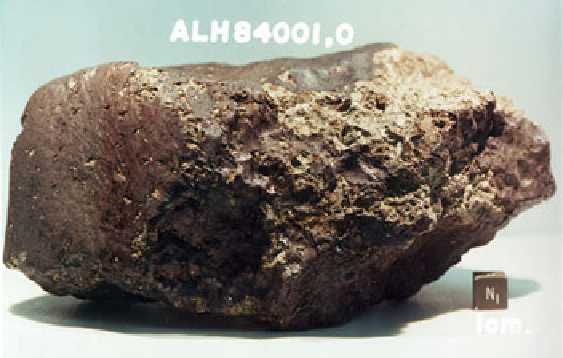Geoscience Reference
In-Depth Information
For general acceptance of past life in a geologic sample, essentially, most or all
of these criteria must be met. All seven criteria have not yet been met for any of the
Martian samples, but continued investigations are in progress.
As of 2014, reexaminations of the biomorphs found in the three Martian
meteorites are underway with more advanced analytical instruments than previously
available.
ALH84001
The ALH84001 meteorite was found in December 1984 in Antarctica, by members
of the ANSMET project; the meteorite weighs 1.93 kg (4.3 lb). The sample was
ejected from Mars about 17 Ma ago and spent 11,000 years in or on the Antarctic
ice sheets. Composition analysis by NASA revealed a kind of magnetite that on
Earth is only found in association with certain microorganisms (Fig.
8.25
).
Then in August 2002, another NASA team led by Thomas-Keprta published a
study indicating that 25 % of the magnetite in ALH84001 occurs as small, uniform-
sized crystals that, on Earth, is associated only with biological activity and that
the remainder of the material appears to be normal inorganic magnetite (Thomas-
Keprta et al.
2009
). The extraction technique did not permit the determination as
to whether the possibly biological magnetite was organized into chains as would be
expected. The meteorite displays indication of relatively low-temperature secondary
mineralization by water and shows evidence of pre-terrestrial aqueous alteration.
Evidence of polycyclic aromatic hydrocarbons (PAHs) has been identified with the
levels increasing away from the surface.
Fig. 8.25
Mars meteorite ALH84001
(
http://www.lpi.usra.edu/lpi/meteorites/The_Meteorite.
shtml
- NASA-JSC/Lunar and Planetary Institute, 1996)

Search WWH ::

Custom Search